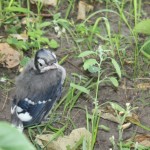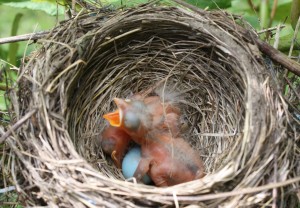A few nights ago we heard an unfamiliar sound – a persistent, high-pitched squawk – through the open dining room window. What could it be? A small mammal in its death throes? I padded barefoot around the back yard, listening, and got a surprise: the sound was coming from two directions, maybe more. Back inside, I made a wild guess and a quick internet search, which confirmed my suspicions. We had newly fledged great horned owls in our neighborhood.
The next morning, as I walked upstream along the river, an American redstart flew across my path and into a small tree where she delivered a morsel into the mouth of a waiting baby bird. Another sign of the season.
It’s still July, and the temperatures in Wisconsin have only begun to rise, but one of the hallmarks of summer is coming to a close: breeding season for birds. Already I miss the spring chorus of birdsong and the courtship displays of May and June. But now there’s something else to see.
As summer progresses, the baby birds that resulted from all that springtime romance are preparing to leave the nest and become independent. At the moment, however, they are extravagantly needy. They still need protection from predators. Some must be coaxed to fly. And most of all, they want food: “Mom, what’s for lunch what’s for dinner can I have a snack can I have more? Mom, I’m HUNGRY!!”
Young birds have just weeks to grow strong enough for a migration of hundreds or thousands of miles – or, if they’re year-round residents, to prepare for winter’s perils. This exigency, combined with their youthful inexperience, makes them noisy and unwary, which can be good news for birdwatchers.
What’s the hysterical racket coming from that tree? A nest that was well hidden this spring may be easy to locate now: just follow your ears. Watch for just a few minutes, and a frantic parent is bound to arrive, delivering one insect after another, and too busy to be secretive.
After they leave the nest, fledglings continue to make a spectacle of themselves. They may sit on a wire or bare branch, ruffling their feathers and looking forlorn. Some call incessantly: cheep, cheep, cheep, cheep, cheep, cheep, cheep, cheep, cheep, cheep, cheep, cheep…
Fledglings of some species look quite similar to their parents; other fledglings’ markings differ from the adults of their species, but they generally bear enough “family resemblance” to allow a good guess. And the incautious baby bird may sit there and wait all the while that you shrug off your backpack, pull out your field guide, and flip through the pages to confirm your guess.
Some people might call this “easy birding,” and maybe it is. It’s also a pleasant opportunity to watch young creatures learn about their surroundings and to contemplate all the new life in your part of the world.



